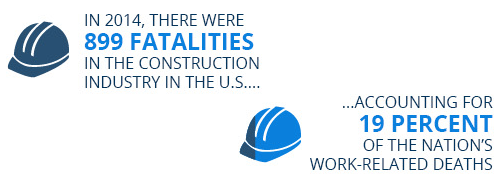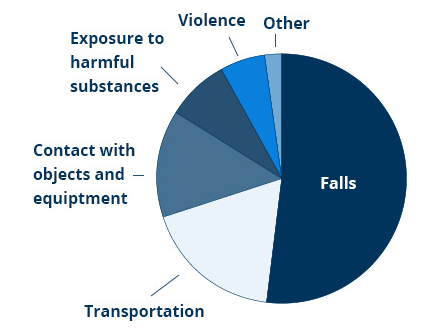The numbers don’t lie: The most dangerous jobs you can work in New York State – or anywhere else in the country, for that matter – are found within the construction industry. For the thousands of workers in New York who climb ladders and scaffolds each day, the risk of falling is a constant.
Recently, contractors, property owners, and insurance giants have waged a war to weaken New York’s existing scaffold law, disregarding the safety of workers and the risks they take every day to perform their jobs far above the ground.
Construction had the most fatal occupational injuries out of all industries in the United States and in New York in 2014, according to the most recent national statistics released by the Bureau of Labor Statistics (BLS).

[note note_color=”#e9f3f7″ radius=”0″]During that year, there were 899 fatalities in the construction industry in the U.S., accounting for 19 percent of the nation’s 4,821 total work-related deaths.[/note]
| Fatal Occupational Injuries – United States – 2014 | |
| Industry | Fatalities |
| Construction | 899 |
| Transportation & Warehousing | 766 |
| Agriculture, Forestry, Fishing & Hunting | 584 |
| Government | 435 |
| Professional & Business Services | 425 |
| All Industries | 4,821 |
However, while construction had the highest total number of deaths, the industry did not have the highest fatality rate (number of deaths per 100,000 full-time equivalent workers). Instead, the agriculture, forestry, fishing and hunting industry had the highest rate at 25.6.
| Fatality Rate – United States – 2014 | |
| Industry | Rate |
| Agriculture, Forestry, Fishing & Hunting | 25.6 |
| Mining & Extraction | 14.2 |
| Transportation & Warehousing | 14.1 |
| Construction | 9.8 |
| Wholesale Trade | 5.1 |
| All Industries | 3.4 |
| Fatal Occupational Injuries – New York – 2014 | |
| Industry | Fatalities |
| Construction | 50 |
| Government | 37 |
| Agriculture, Forestry, Fishing & Hunting | 27 |
| Transportation & Warehousing | 19 |
| Leisure & Hospitality | 19 |
| All Industries | 241 |
Why Are Construction Jobs So Dangerous?
Construction workers simply face a wide range of hazards when they arrive at the job site each morning. As the below BLS statistics show, falls from heights such as roofs, ladders and scaffolding clearly present the deadliest risk:

Among the many other risks that New York construction workers face on the job are:
[note note_color=”#e9f3f7″ radius=”0″]- Getting struck by objects and materials such as tools or debris
- Accidents involving trucks, forklifts, demolition and excavation machinery and equipment
- Burns from fires, explosions and electricity mishaps
- Using dangerous tools, machines and materials
- Handling and moving heavy materials
- Trench collapses or cave-ins
- Being exposed to the elements and air contaminants.[/note]
While some of these risks are inherent in construction work, many of them can be minimized or eliminated altogether by employers in the construction industry strictly following state and federal safety regulations.
In fact, New York Labor Laws require employers in the construction industry “to provide reasonable and adequate protection for the lives, health and safety” of their workers and all of those in the area of construction activity.
Any construction site owner or contractor who fails to live up to this duty may be held liable for any harm that results from this neglect, regardless of what a contract states or what local customs and practices may be.
At issue: An effective scaffold law
The current scaffold law dates to the late 1800s when advances in construction techniques allowed the building of the early skyscrapers. Construction workers faced new risks as they climbed scaffolds into the sky to make New York City what it is today. The law was an effort to protect them, and it has done so by holding contractors and developers responsible for the safety of job sites.
Although the law has gone through various changes since 1885, its premise is the same: to keep workers safe.
Under the scaffold law, employers and property owners can be held responsible when a construction worker is hurt from a gravity-related injury due to ineffectual safety measures. The law places the responsibility of keeping scaffold workers safe squarely on the shoulders of their employers and the owners of the site, as it should be.
The campaign to change the current law is being led by those who want the benefit of the workers’ labor without bearing the responsibility for their safety. Contractors and property owners say the law has led to skyrocketing insurance rates and an environment where nearly any fall injury is met with a disproportionate financial reward. Interestingly, their claims are supported by the insurance companies and their teams of lobbyists who, rather than looking at how to lower rates, have joined in the fight to absolve those in charge of responsibility.
Furthermore, the law is designed to prevent recovery for injury caused by the injured parties own negligence. If a contractor or property owner can establish that the accident was not caused by a violation of the statute, or that the violation was not a proximate cause of the accident, then the contractor or property owner cannot be liable.
The law itself does not apply to one- and two-family homes where the owner does not direct or control the work. However, if a homeowner acts as his or her own general contractor and hires and supervises the various sub-contractors, then he or she may be found liable under this statute.
Opponents would tell you that New York’s law is the only one like it in the country. But that is incorrect. At least seven other states have similar or even more restrictive laws, according to Gary La Barbera of the Building and Construction Trades Council of Greater New York.
Opponents also point to Illinois, which repealed its scaffold law in 1995, saying that the state’s construction industry has flourished since the repeal. Again, they are wrong. La Barbera says that Illinois has lost 35,000 jobs since the repeal, whereas New York has gained 60,000. Further, New York has surpassed Illinois in construction growth in each of the past 15 years.
Why it matters
Falls are the leading cause of death in construction work. In 2010, the Bureau of Labor Statistics reported 751 construction casualties, 35% of which were due to fall accidents. While these accidents can happen when workers fall from roofs or even trip on the ground, a great number are caused when construction workers fall from ladders and scaffolds.
New York is like no other state—with far more skyscrapers and tall buildings. Construction work is dangerous no matter where you are, but the risks are very different when you are working high above the ground.
Construction can be a good job. A tradesman can make a decent living and provide for his family. But if a significant injury happens, it can rob him of his livelihood.
Often these accidents can be directly traced to safety deficiencies on the job. The worker may go to work each day and follow policy and procedures to ensure he arrives home safely each night, but if the contractor or property owner fails to provide a safe environment, including scaffolds, all his care and work is in vain.
The current scaffold law works as it should, to protect those that build our homes, offices, hospitals, schools, and more. And the current scaffold law should remain as written.
[note note_color=”#e9f3f7″ radius=”0″]It is important to seek help from a law firm that has experience with handling construction site injury and wrongful death cases, including cases in which compensation is pursued through New York Labor Laws.For nearly three decades, the personal injury lawyers of Powers & Santola, LLP, have helped injured construction workers and their families in Albany, Syracuse and throughout New York to seek the justice and compensation they deserved.
We can review your case today. Contact us for a free consultation.[/note]

